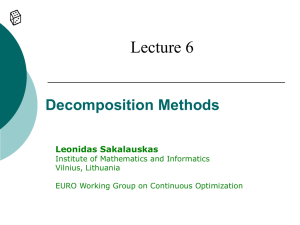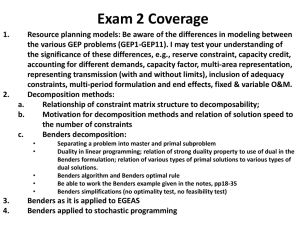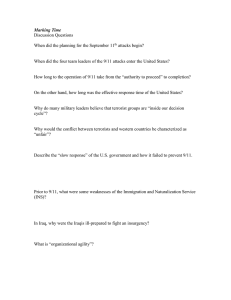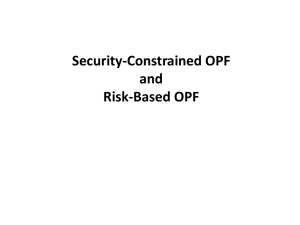A Benders Decomposition Approach to Corrective
advertisement
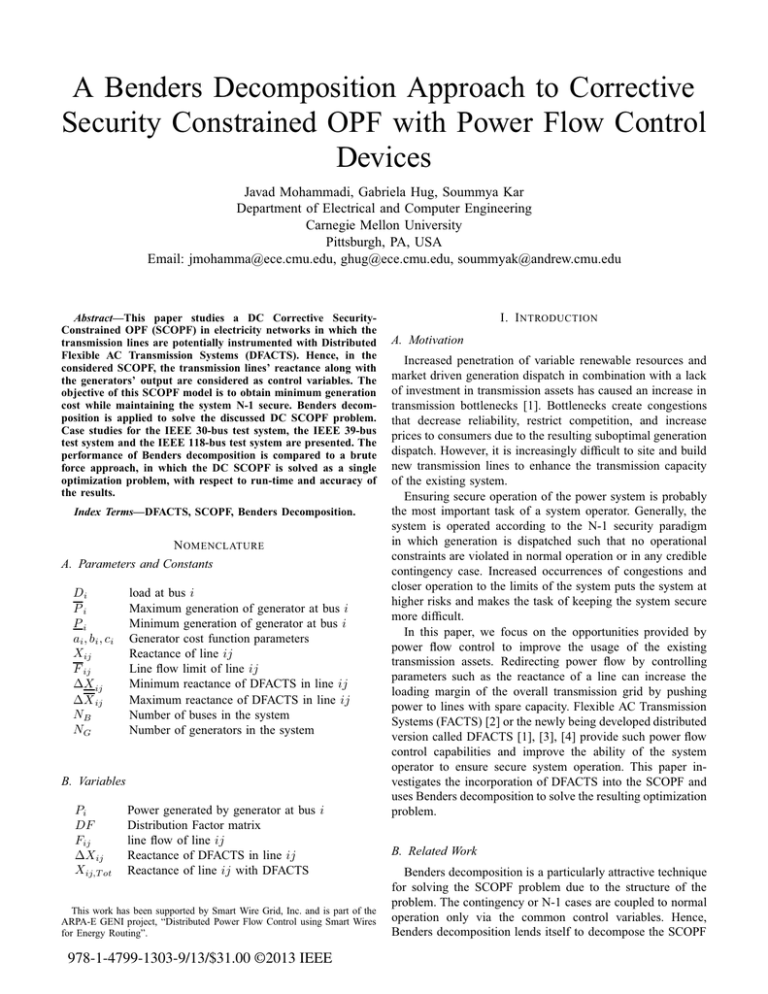
A Benders Decomposition Approach to Corrective Security Constrained OPF with Power Flow Control Devices Javad Mohammadi, Gabriela Hug, Soummya Kar Department of Electrical and Computer Engineering Carnegie Mellon University Pittsburgh, PA, USA Email: jmohamma@ece.cmu.edu, ghug@ece.cmu.edu, soummyak@andrew.cmu.edu Abstract—This paper studies a DC Corrective SecurityConstrained OPF (SCOPF) in electricity networks in which the transmission lines are potentially instrumented with Distributed Flexible AC Transmission Systems (DFACTS). Hence, in the considered SCOPF, the transmission lines’ reactance along with the generators’ output are considered as control variables. The objective of this SCOPF model is to obtain minimum generation cost while maintaining the system N-1 secure. Benders decomposition is applied to solve the discussed DC SCOPF problem. Case studies for the IEEE 30-bus test system, the IEEE 39-bus test system and the IEEE 118-bus test system are presented. The performance of Benders decomposition is compared to a brute force approach, in which the DC SCOPF is solved as a single optimization problem, with respect to run-time and accuracy of the results. Index Terms—DFACTS, SCOPF, Benders Decomposition. N OMENCLATURE A. Parameters and Constants Di Pi Pi ai , b i , c i Xij F ij ΔX ij ΔX ij NB NG load at bus i Maximum generation of generator at bus i Minimum generation of generator at bus i Generator cost function parameters Reactance of line ij Line flow limit of line ij Minimum reactance of DFACTS in line ij Maximum reactance of DFACTS in line ij Number of buses in the system Number of generators in the system B. Variables Pi DF Fij ΔXij Xij,T ot Power generated by generator at bus i Distribution Factor matrix line flow of line ij Reactance of DFACTS in line ij Reactance of line ij with DFACTS This work has been supported by Smart Wire Grid, Inc. and is part of the ARPA-E GENI project, “Distributed Power Flow Control using Smart Wires for Energy Routing”. 978-1-4799-1303-9/13/$31.00 ©2013 IEEE I. I NTRODUCTION A. Motivation Increased penetration of variable renewable resources and market driven generation dispatch in combination with a lack of investment in transmission assets has caused an increase in transmission bottlenecks [1]. Bottlenecks create congestions that decrease reliability, restrict competition, and increase prices to consumers due to the resulting suboptimal generation dispatch. However, it is increasingly difficult to site and build new transmission lines to enhance the transmission capacity of the existing system. Ensuring secure operation of the power system is probably the most important task of a system operator. Generally, the system is operated according to the N-1 security paradigm in which generation is dispatched such that no operational constraints are violated in normal operation or in any credible contingency case. Increased occurrences of congestions and closer operation to the limits of the system puts the system at higher risks and makes the task of keeping the system secure more difficult. In this paper, we focus on the opportunities provided by power flow control to improve the usage of the existing transmission assets. Redirecting power flow by controlling parameters such as the reactance of a line can increase the loading margin of the overall transmission grid by pushing power to lines with spare capacity. Flexible AC Transmission Systems (FACTS) [2] or the newly being developed distributed version called DFACTS [1], [3], [4] provide such power flow control capabilities and improve the ability of the system operator to ensure secure system operation. This paper investigates the incorporation of DFACTS into the SCOPF and uses Benders decomposition to solve the resulting optimization problem. B. Related Work Benders decomposition is a particularly attractive technique for solving the SCOPF problem due to the structure of the problem. The contingency or N-1 cases are coupled to normal operation only via the common control variables. Hence, Benders decomposition lends itself to decompose the SCOPF problem into a master problem corresponding to normal operation and N subproblems each corresponding to a contingency cases. This facilitates parallel computing and managing the large scale of the original optimization problem. Benders decomposition has been mostly used to solve SCOPF problems to determine the most cost effective generation dispatch fulfilling N-1 security constraints, e.g. [5], [6]. In [7], Benders decomposition is used to determine the security constrained unit commitment, in which generation redispatch is considered as a corrective action. Several implementation techniques of Benders decomposition for solving the DC security constrained unit commitment are compared in [8] with respect to run-time and result accuracy. Also, [9] proposes two decomposition algorithms based on the Benders cut and alternating direction method of multipliers for solving the SCOPF problem. However, in these references no power flow control devices are considered. Benders decomposition’s applications with regards to power flow control devices include the determination of the optimal placement of FACTS devices, e.g. [10]. By adopting a multi starting point approach, it is suggested to use Benders decomposition to maximize the loading margin of the network. Examples for approaches to determine the optimal settings of power flow control devices in which no Benders Decomposition is employed include e.g. [11], [12]. In [11], a linearized model to incorporate a Unified Power Flow controller as power flow controller into the Security Constraint Optimal Power Flow (SCOPF) is suggested whereas in [12] a control region for compact and reduced SCOPF formulation that utilizes FACTS is defined in a way in which a global optimum can be achieved. In this paper, we incorporate power flow control devices into a SCOPF and use Benders decomposition to solve the resulting optimization problem. We study the performance of Benders decomposition compared to a brute force approach and also compare the effect of ubiquitous power flow controllers on run-time and achieved solution compared to the case without such devices. Furthermore, we study the effect of diminishing return of increasing the possible operating range of such power flow control devices. C. Paper Organization The rest of the paper is structured as follows: DFACTS and SCOPF modeling approaches are discussed in Section II. Section III presents the problem formulation and how Benders decomposition is employed to solve this problem. Section IV describes the test case system and presents simulation results. Finally, Section V concludes the paper. ΔXij Fig. 1. In this paper, we consider Distributed Series Reactance (DSR) and Distributed Series Impedance (DSI) as the devices providing the capability for power flow control [3]. Both of these devices effectively influence the reactance of the line in which they are placed. Hence, we model them as variable DFACTS modules on power line. reactances ΔXij in series with the line reactance Xij (see Fig. 1) resulting in a total line reactance of Xij,T ot = Xij + ΔXij (1) The difference between the two types of devices is that the DSR can only provide inductive compensation, i.e., 0 ≤ ΔXij,DSR ≤ ΔX ij (2) and therefore can only push power to parallel lines. The DSI on the other hand is capable of providing inductive as well as capacitive compensation, i.e., ΔX ij ≤ ΔXij,DSI ≤ ΔX ij (3) where ΔX ij is a negative value. Hence, these devices are able to increase or decrease the power through the line in question by pushing power to or drawing power from the rest of the system. B. Corrective Control Traditionally, the system is operated according to N-1 security constraints, i.e. a single element failure may not lead to any operational constraint violations. Hence, the set of N-1 security constraints needs to be taken into account when determining the generation dispatch to ensure that if a contingency occurs no element is overloaded. We refer to the case in which the N-1 security constraints need to be fulfilled without any corrective actions once the contingency occurs as the preventive approach. The approach in which corrective actions are allowed is referred to as corrective approach. Corrective SCOPF is based on the ability of the system to tolerate short-term violations and perform fast corrective actions after a fault occurred. In other words, in the case of a contingency the system should be able to reach a secure operation state before the violations of operational constraints have any consequences. Due to the fast response of power flow control devices, these devices may provide such corrective actions and hence reduce the cost of ensuring system’s security. The compact formulation of corrective SCOPF assuming corrective actions provided by the DFACTS is given by min II. M ODELING A. Power Flow Control Xij Pi ,XT0 ,...,XTN NG Ci (Pi ) (4) i=1 s.t. g0 (XT0 , P ) = h0 (XT0 , P ) ≤ 0 h̄ (5) (6) gq (XTq , P ) = hq (XTq , P ) ≤ 0 q = 1, . . . , N h̄ q = 1, . . . , N (7) (8) where q = 1, . . . , N refers to the contingencies considered in the SCOPF. In this paper, such contingencies correspond to line failures which do not lead to any islands in the system. The decision variable P corresponds to the vector of generator output settings and XT0 and XTq are the DFACTS setting in normal operation and each of the contingencies, respectively. Equality constraints (5) and (7) represent the load balance equation for normal and contingency cases. Constraints on decision variables and operational constraints are included in (6) and (8) for normal and contingency cases, respectively. Such constraints correspond to limits on power flow control device settings as well as limits on generation output. Operational constraints include limits on line flows. III. P ROBLEM F ORMULATION Due to the large size of the electric power system, the security constrained optimization problem usually results in a large scale optimization problem. The Benders decomposition is one of the commonly used decomposition techniques in power systems to solve the SCOPF problem, that can be applied to take advantage of the underlaying problem structure. In applying Benders decomposition the complexity of the problem is reduced by decomposing the original problem into a master problem and several subproblems [13]. The algorithmic approach for solving SCOPF using Benders decomposition is depicted in Fig. 2. In case of the SCOPF problem, the master problem corresponds to the problem of minimizing generation dispatch cost by taking into account only the constraints for normal operation. Each subproblem then corresponds to examining the feasibility of the master problem’s solution with respect to the constraints for each contingency case [13]. The formulation of the master problem (the upper dashed box in Fig. 2) is given as follows: min NG (ai · Pi2 + bi · Pi + ci ) Pk − Dk = (9) Fkn , k = 1, . . . , NB = DF · (Pk − Dk ), kn ∈ ΩL ΔX kn ≤ ΔXkn Pi ≤ −F kn < Pi Fkn Fig. 2. Structure of SCOPF with Benders decomposition. By solving the master problem, the optimal values for con∗ trol variables P ∗ and ΔXkn in the normal case are obtained Then, the feasibility of the master problem’s solution for each of the contingency cases is examined in the subproblems. The goal of this feasibility check is to ensure that the master problem’s solution satisfies all operational constraints, such as line limits, in the contingency cases. To perform the feasibility check, slack variables rkn for the operational constraints are introduced and the following optimization problem is solved for each contingency q: w = min s.t. Pk − Dk (10) n∈Ωk Fkn (11) ≤ ΔX kn , kn ∈ ΩL (12) ≤ P i, < F kn , (13) (14) infeasibility cut i = 1, . . . , NG kn ∈ ΩL ΩL rkn (16) k=1 i=1 s.t. (15) where ΔXkn is the variable reactance introduced by the DFACTS, Ωk are the buses to which bus k is connected and ΩL are the lines in the system. If no generation and/or no load is connected to bus k, Pk and/or Dk for that bus are equal to zero. Line flows Fkn are defined in (11) where DF is the distribution factor matrix. It should be noted that the distribution factor matrix is a function of the DFACTS settings ΔXkn rendering the problem non-convex. q Fkn = n∈Ωk q q Fkn , k = 1, . . . , NB = DF · (Pk − Dk ), kn ∈ ΩL ΔX kn ≤ −F kn − rkn < rkn P q ΔXkn q Fkn ≥ = ≤ ΔX kn , (17) (18) kn ∈ ΩL (19) < F kn + rkn , kn ∈ ΩL (20) 0 (21) P∗ : λ1 (22) where λ1 is the Lagrangian multiplier of the equality constraint in (22). If the optimal value of the objective function optimal is non-zero, then the master problem’s optimal values do not satisfy the constraints in the contingency case. In case that the determined generation dispatch does not satisfy the operational constraints for a specific contingency, the following constraint is added to the master problem as a so-called infeasibility or Benders cut w∗ + λ1 (P − P ∗ ) ≤ 0, (23) IV. S IMULATION R ESULTS A. Test Systems The IEEE 30-bus [14], the IEEE 39-bus [15] and the IEEE 118-bus test systems [14] are used to investigate the effects of utilizing DFACTS to ensure N-1 secure operation of the power system. We consider various operational ranges for the DFACTS devices from a margin of 10% compensation up to 50% compensation of the transmission lines. Also, we assume that all of the lines are equipped with DFACTS to study the effect of ubiquitous power flow control on the computational performance of Benders decomposition. Line limits for both systems have been chosen such that they reflect likely limits given the initial operational state of these systems. The cost parameters for the generators were derived from heat rate curves given in the IEEE Reliability Test System and recent fuel costs. The simulations were carried out in MATLAB using the KNITRO solver of the commercial optimization package Tomlab on a core i7 3.4 GHz windows platform. This is especially important for Sect. IV.C where we compare computation time between the brute force approach, in which all N-1 constraints are included in a single optimization problem solved using Tomlab, and the Benders Decomposition approach in which the smaller master and subproblems are each solved using the same commercial software. B. Cost Comparison Tables I-III show the generation cost of SCOPF calculations for the various considered levels of compensation ranges of DFACTS. Based on these results, obviously, as the compensation ratio increases, the SCOPF procurement cost reduces. In other words, as DFACTS compensation ratio increases, the system flexibility to handle contingencies increases, thereby enabling a cheaper generation dispatch. TABLE I C OSTS ( IN $) FOR GENERATION DISPATCH FULFILLING N-1 SECURITY CONSTRAINTS FOR THE IEEE 30-B US TEST SYSTEM TABLE II C OSTS ( IN $) FOR GENERATION DISPATCH FULFILLING N-1 SECURITY CONSTRAINTS FOR THE IEEE 39-B US TEST SYSTEM ΔX kn ,ΔX kn 0.1 0.2 0.3 0.4 0.5 w/o DFACTS 22134 22134 22134 22134 22134 DFACTS as DSR 22053 21977 21984 21946 21910 DFACTS as DSI 21961 21910 21778 21612 21358 TABLE III C OSTS ( IN $) FOR GENERATION DISPATCH FULFILLING N-1 SECURITY CONSTRAINTS FOR THE IEEE 118-B US TEST SYSTEM ΔX kn ,ΔX kn 0.1 0.2 0.3 0.4 0.5 w/o DFACTS 118300 118300 118300 118300 118300 DFACTS as DSR 117491 116975 116409 115887 115450 DFACTS as DSI 116850 115456 113925 112370 110560 Moreover, the impact of DFACTS on system operation differs based on their capability to alter the line reactance. DSI can improve the transfer capacity of the network more than DSR, because it can decrease the reactance of uncongested lines while increasing the reactance of congested lines. Although, the SCOPF cost decreases with increasing compensation ratio, a saturation is observed. This confirms that there is a limit on the performance improvement that may be achieved by using DFACTS. This limit is reached when all parallel lines reach their limits. The saturation trend is also observed in Fig. 3, which plots the SCOPF calculation cost as a function of the various considered levels of DFACTS compensation ranges. However, the saturation point or the best achievable performance depends heavily on the system topology and the generator cost functions. C. Computational Aspect This section discusses the computational aspects related to applying Benders decomposition to solve the SCOPF problem. It should be noted that the incorporation of DFACTS into the SCOPF problem renders the problem non-convex. On the other hand, Benders decomposition requires that the objective function of the considered problem projected on the subspace of the complicating variables has a convex hull. Unfortunately, DFACTS as DSR DFACTS as DSI 5000 4500 SCOPF cost where the variable w∗ represents the optimal value of subproblem’s objective function (16). The goal of adding this constraint to the master problem is to force w to be less than or equal to zero in the next iteration, and therefore, make the subproblem (16)-(22) feasible. Iterations between master and subproblems are continued until the master problem’s optimal solution satisfies all of the subproblems’ constraints. It should be noted that changing the DFACTS setting is the only corrective action that is considered in this paper. Hence, the master problem’s optimal generation dispatch P ∗ is assumed to be fixed in the subproblems indicated by (22). However, settings of DFACTS may be modified in the case of each contingency. 4000 3500 3000 ΔX kn ,ΔX kn 0.1 0.2 0.3 0.4 0.5 w/o DFACTS 5029 5029 5029 5029 5029 DFACTS as DSR 4756 4529 4333 4167 4033 DFACTS as DSI 4480 4032 3862 3809 3809 2500 0 0.1 0.2 0.3 0.4 0.5 0.6 Range of DFACTS setting 0.7 0.8 0.9 Fig. 3. SCOPF cost with respect to DFACTS setting range (IEEE 30-Bus test system). 96 0.6 95.8 0.4 95.6 0.2 95.4 0 0.1 0.15 0.2 0.25 0.3 0.35 Range of DFACTS setting 0.4 0.45 95.2 0.5 Percentage of Difference Between the Run−Time of BF and BD Percentage of Difference Between the Results of BF and BD 0.8 Fig. 4. Comparing run time improvement versus result difference (IEEE 39-Bus test system). the problem we applied Benders decomposition. We allowed for corrective actions by the power flow control devices. It is assumed that once a contingency occurs the settings of these devices may be adjusted to resolve violations of operational constraints. The numerical studies show that with DFACTS devices the system can operate N-1 secure at lower cost. Moreover, we discuss the Benders decomposition applicability for solving this paper’s problem. Due to the non-convex nature of problem, the results obtained from the Benders decomposition may differ form the ones obtained from the brute force approach results. However, from the run-time perspective Benders decomposition contribution for solving this problem is considerable. R EFERENCES this is not the case for this paper’s problem due to the nonconvexity of the problem. Hence, it may happen that the result of Benders decomposition method differs from the brute force approach [10]. In [5], similar concerns are mentioned regarding the application of Benders decomposition. This reference presents a comparison between decomposed and unified (brute force) implementation of SCOPF with respect to run-time and result accuracy. The authors concluded that applying Benders decomposition results in significantly better computing speed without significantly sacrificing accuracy. Fig. 4 compares results from the Benders decomposition (BD) and the brute force (BF) approach and the respective run-times to obtain these results for the 39 bus system. The percentage of difference between the discussed approaches is calculated as: BF Result − BD Result × 100 BF Result Hence, although Benders decomposition seems to compromise the result by a minimal amount (less than 0.5%) its run-time improvement is considerable (more than 95%). Table IV shows the run-times for the IEEE 30-Bus and the IEEE 118-Bus test systems, our Benders’ Decomposition approach yields the same results as the Brute Force, though with a considerable run-time improvement. On the other hand, it is seen that the Brute Force method can not handle the SCOPF problem for the IEEE-118 bus test system. It should be noted that, computation time is dependent on how many congestions arise and also how it is implemented and what computer is used. V. C ONCLUSION In this paper, we studied the benefits of utilizing power flow control devices for corrective power flow control with respect to the generation cost. In order to reduces the complexity of TABLE IV C OMPUTING T IME FOR IEEE 30-B US AND IEEE 118-B US TEST SYSTEMS w/o DFACTS DFACTS as DSR DFACTS as DSI 30-Bus test system BF (s) BD (s) 0.64 3 367.23 30.32 431.72 21.56 118-Bus BF (s) 600 NA NA test system BD (s) 632.38 1726.8 1373.8 [1] F. Kreikebaum, D. Das, Y. Yang, F. Lambert, and D. Divan, “ Smart Wires: A Distributed, Low-Cost Solution for Controlling Power Flows and Monitoring Transmission Lines”, ISGT 2010. [2] N.G. Hingorani, L. Gyugyi, “Understanding FACTS: Concepts and Technology of Flexible AC Transmission Systems,” IEEE Press, 1999. [3] H. Johal, “Distributed series reactance: a new approach to realize grid power flow control”, PhD dissertation, Dept. Elect. Eng., Georgia Institute of Technology, GA, 2008. [4] D. Divan, and H. Johal, “Distributed FACTS-a new concept for realizing grid power flow control”, IEEE Trans. Power Electron, pp. 2253 - 2260, June, 2007. [5] L. Yuan, and J. D. McCalley, “Decomposed SCOPF for improving efficiency”, IEEE Transactions on Power Systems, vol. 24, no. 1, pp. 494495, 2009. [6] A. Monticelli, M.V.F. Pereira, and S. Granville, “Security-constrained optimal power flow with post-contingency corrective rescheduling”, IEEE Transactions on Power Systems, vol. 2, no. 1, pp. 175180, 1987. [7] Fu. Yong, M. Shahidehpour, and Li. Zuyi, “AC Contingency Dispatch Based on Security-Constrained Unit Commitment”,IEEE Trans. Power Sys, Vol.21, no. 2, pp. 897 - 908, May, 2007. [8] S. Cvijic, and Xiong. Jinjun, “Security Constrained Unit Commitment and Economic Dispatch Through Benders Decomposition: A comparative Study”,PES General Meeting, 2011. [9] D. Phan, and J. Kalagnanam, “Distributed methods for solving the security-constrained optimal power flow problem”, Innovative Smart Grid Technologies Conference, Washington DC, 2012. [10] R. Minguez, F. Milano, R. Zarate-Miano, A.J. Conejo, “Optimal Network Placement of SVC Devices” IEEE Trans. Power Sys, Vol.22, no. 2, pp. 1851 - 1860, Nov, 2007. [11] Shao. Wei, and V. Vittal, “LP-Based OPF for Corrective FACTS control to Relieve Overloads and Voltage Violations”, IEEE Trans. Power Sys, Vol.21, no. 4, pp. 1832 - 1839 ,Nov, 2006. [12] A. Berizzi, M. Delfanti, P. Marannino, M.S. Pasquadibisceglie, and A. Silvestri, “Enhanced Security-Constrained OPF with FACTS Devices”, IEEE Trans. Power Sys, Vol.20, no. 3, pp. 1597 - 1605 , Aug 2005. [13] M. Shahidehopour, and Fu. Yong, “Benders decomposition applying Benders decomposition to power systems”, Power and Energy Magazine, Vol. 3, no. 2, pp. 20 - 21, March, 2005. [14] Available: http://www.ee.washington.edu/research/pstca/ [15] Available: http://scholar.lib.vt.edu/theses/available/etd-61797-12279/ unrestricted/Chapt3c.pdf
